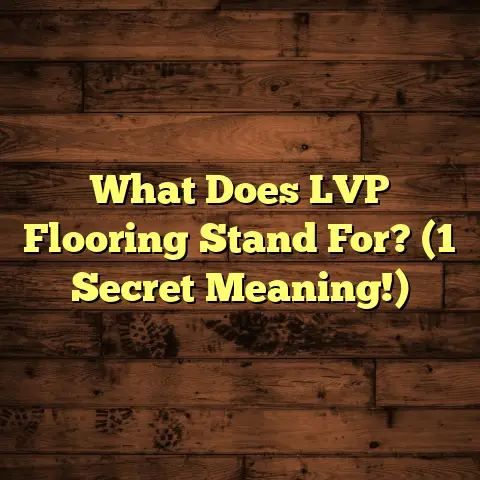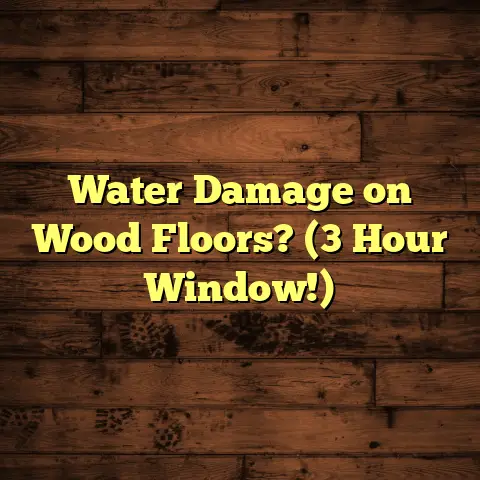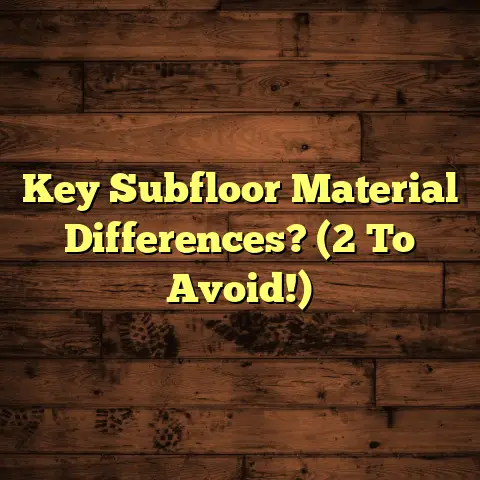The Most Common Types Of Hardwood Flooring? (Explained)
I can still vividly recall the moment I stepped into a home with stunning hardwood flooring that seemed to tell a story of its own.
The soft glow of the polished wood underfoot, the intricate patterns of grain weaving through each plank—there’s an undeniable charm about hardwood that captivates homeowners and contractors alike.
Over the years as a flooring contractor, I’ve had the pleasure of working with various hardwoods and witnessing firsthand how they transform spaces.
In this article, I’ll share my experiences with the most common types of hardwood flooring.
From oak to bamboo, I’ll delve deep into their characteristics, installation processes, maintenance tips, cost considerations, and personal anecdotes that highlight their unique qualities.
Oak Hardwood Flooring
Oak is often the poster child for hardwood flooring.
Its strength, durability, and timeless beauty make it a go-to choice for many homeowners.
As I’ve worked on countless projects involving oak, I’ve come to appreciate its versatility.
The Different Varieties of Oak
There are two primary types of oak used in flooring: red oak and white oak.
- Red Oak: Known for its warm tones and pronounced grain patterns, red oak has been a favorite for traditional and transitional designs.
It has a Janka hardness rating of 1290, making it moderately durable. - White Oak: With a more subtle grain and cooler tones, white oak tends to be more resistant to moisture.
It has a Janka hardness rating of 1360, which makes it slightly tougher than red oak.
My Journey with Oak Flooring
One memorable project involved a sprawling suburban home where the clients wanted to create a warm and inviting atmosphere.
After discussing their preferences, we settled on installing red oak planks.
The installation process was straightforward.
We chose 3/4-inch thick planks that were 4 inches wide.
The living room came alive as we laid down the first few boards; the rich color instantly transformed the space.
Each plank’s distinct grain added character and warmth.
Cost Considerations
The cost of oak flooring typically ranges from $3 to $8 per square foot.
For this project, we estimated around $5 per square foot, which included both materials and installation.
Using FloorTally was crucial in providing accurate estimates since it accounted for local labor rates and material costs.
Challenges with Oak Flooring
While oak is a beautiful choice, it does come with its challenges.
One issue I frequently encounter is its susceptibility to scratches.
Clients often have children or pets, increasing the likelihood of damage.
To combat this, I always recommend area rugs in high-traffic zones and regular refinishing every 5-10 years to maintain its luster.
Maple Hardwood Flooring
Maple is another popular option that offers a clean, modern aesthetic.
Known for its fine grain and light color, maple has become increasingly favored in contemporary homes.
Understanding Maple Flooring
Maple comes in two primary varieties: hard maple and soft maple.
- Hard Maple: This variety is often used for flooring due to its durability and resistance to wear.
It has a Janka hardness rating of 1450, making it suitable for high-traffic areas. - Soft Maple: While still beautiful, soft maple is less durable and usually used for furniture rather than flooring.
A Memorable Maple Project
I once worked on a chic urban loft where the homeowners desired an open, airy feel.
We decided on hard maple flooring to match their modern design aesthetic.
The installation process was seamless; we acclimated the wood properly to avoid any issues down the line.
As we installed the 5-inch wide planks, I couldn’t help but admire how the light reflected off the smooth surface, creating an illusion of more space.
The final product was nothing short of stunning.
Cost Insights
Maple flooring generally costs between $4 and $9 per square foot.
For this loft project, we estimated about $6 per square foot using FloorTally to ensure transparency in budgeting.
Maintenance Tips for Maple
Maple is relatively low-maintenance but still requires some care to keep it looking its best:
- Regular Cleaning: Use a soft broom or vacuum designed for hardwood to remove dirt and debris.
- Avoid Excessive Moisture: Wipe up spills immediately to prevent water damage.
- Refinishing: Consider refinishing every 5-7 years based on traffic levels to maintain its pristine appearance.
Hickory Hardwood Flooring
Hickory is renowned for its strength and distinctive appearance.
It features dramatic grain patterns and color variations that can add depth to any room.
The Unique Characteristics of Hickory
Hickory is one of the hardest domestic woods available, with a Janka hardness rating of 1820.
This makes it an excellent choice for families or anyone looking for something that can withstand heavy foot traffic.
My Experience with Hickory
I once worked on a rustic cabin renovation where the homeowners wanted a flooring option that would complement their log walls.
We chose hickory for its durability and unique character.
The installation was slightly more challenging due to the wood’s density; I had to use specialized tools to cut and shape the planks correctly.
However, once installed, the hickory planks transformed the space into a cozy retreat.
Cost Considerations
Hickory generally falls within the $5-$10 per square foot range.
For this cabin project, we estimated around $7 per square foot using FloorTally for accurate budgeting.
Maintenance Advice for Hickory
- Regular Cleaning: Sweeping or vacuuming regularly is essential to prevent dirt buildup in the grooves.
- Humidity Control: Maintaining consistent humidity levels in your home can prevent expansion or contraction of hickory.
- Refinishing: Depending on traffic levels, consider refinishing every 7-10 years to maintain its beauty.
Cherry Hardwood Flooring
Cherry flooring is celebrated for its rich color and smooth texture.
Over time, cherry darkens beautifully, adding warmth and sophistication to any space.
Exploring Cherry’s Characteristics
Cherry is softer than some other hardwoods with a Janka hardness rating of around 950.
While this makes it less durable than oak or hickory, it’s still an excellent choice for low-traffic areas or formal settings.
A Cherry Flooring Project
During a historic home restoration project, I had the opportunity to install cherry flooring in a grand dining room.
The homeowners wanted to preserve the home’s character while updating its functionality.
We selected 3/4-inch thick cherry planks measuring 4 inches wide.
As we installed them, I watched as the deep red tones brought warmth to the space, creating an inviting atmosphere for family gatherings.
Cost Insights
Cherry flooring typically ranges from $6 to $12 per square foot.
For this project, we estimated around $9 per square foot using FloorTally for detailed cost estimation.
Maintenance Tips for Cherry
- Avoid Excessive Sunlight: Cherry can fade when exposed to direct sunlight over time; consider using window treatments.
- Regular Cleaning: Use a soft cloth or broom to maintain its sheen without scratching the surface.
- Refinishing: Depending on usage, refinishing may be necessary every 5-10 years to keep it looking fresh.
Bamboo Hardwood Flooring
Though technically not a hardwood but a grass, bamboo has gained popularity due to its eco-friendliness and unique style.
It’s known for being sustainable and offers a modern look appealing to many homeowners.
Understanding Bamboo Flooring
Bamboo comes primarily in two forms: strand-woven and conventional bamboo planks.
- Strand-Woven Bamboo: This type is made by compressing bamboo fibers under high pressure.
It’s extremely durable with a Janka hardness rating that can exceed 3000. - Conventional Bamboo Planks: These are made from bamboo stalks and are less durable but still offer aesthetic appeal.
My Bamboo Experience
I once worked with eco-conscious clients who chose strand-woven bamboo for their new home.
The rich golden tones contrasted beautifully against their contemporary décor.
Installation was straightforward; we opted for floating floors as they provide flexibility over concrete slabs.
The final result was stunning—an eco-friendly floor that brought warmth into their home.
Cost Range
Bamboo usually costs between $3 and $8 per square foot.
For this project, our estimate was around $5 per square foot using FloorTally’s efficient budgeting features.
Maintenance Advice for Bamboo
- Regular Cleaning: Sweep or vacuum regularly to prevent dirt buildup.
- Avoid Excessive Moisture: Wipe up spills quickly to prevent water damage; bamboo can be sensitive to humidity changes.
- Refinishing: Depending on traffic levels, refinishing may be needed every 5-10 years.
Other Notable Hardwood Options
Beyond these common types of hardwood flooring, several other options deserve mention due to their unique attributes:
Walnut Hardwood Flooring
Walnut offers deep brown hues with rich grain patterns that add elegance to any space.
With a Janka hardness rating around 1010, it’s softer than oak but still durable enough for many applications.
Installation Insights
I once installed walnut flooring in a luxury condo where the owners wanted something striking yet sophisticated.
The installation process was smooth, and as we laid down the planks, I could see how beautifully they complemented other design elements in their living space.
Cost Considerations
Walnut typically ranges from $6 to $15 per square foot depending on quality and sourcing.
Ash Hardwood Flooring
Ash is known for its light color and straight grain pattern—often used in modern designs.
With a Janka hardness rating around 1320, it’s durable enough for various applications but lighter than oak or hickory.
My Experience with Ash
In one project, I installed ash flooring for a minimalist home where my clients wanted light colors to enhance natural lighting.
The result was stunningly bright and airy, making every room feel open and welcoming.
Cost Insights
Ash usually falls between $4 and $10 per square foot depending on grade and finish options available in your area.
Installation Techniques
When it comes to installing hardwood flooring, several methods can be employed depending on the type of wood and subfloor conditions:
Nail Down Installation
This method involves nailing down solid hardwood planks directly onto a wooden subfloor using special cleats or nails.
It’s ideal for thicker planks like oak or maple.
Glue Down Installation
In this method, adhesive is used to bond engineered hardwood directly onto concrete or plywood subfloors—often used in commercial settings or low-profile installations.
Floating Installation
Floating floors are not attached directly to the subfloor but are instead locked together using tongue-and-groove systems.
This method works well with engineered wood or bamboo products that expand easily with changes in humidity levels.
Maintenance Essentials
Regardless of which type you choose, proper maintenance will extend your hardwood floor’s life significantly:
- Humidity Control: Keep indoor humidity between 30% and 50% using dehumidifiers or humidifiers as needed.
- Rug Placement: Use area rugs in front of entryways or high-traffic areas to protect against wear.
- Scratch Prevention: Place felt pads under furniture legs to minimize scratches during movement.
Final Thoughts on Hardwood Flooring Choices
As I reflect on my journey through various types of hardwood flooring—from oak’s classic charm to bamboo’s sustainability—it’s clear there’s no one-size-fits-all solution.
Each type has its unique attributes that appeal differently based on individual preferences and lifestyles.
If you’re considering new flooring for your home or business, weigh your options carefully while taking into account aesthetics, durability needs, budget constraints, maintenance requirements—and don’t hesitate to reach out for professional help along the way!
Hardwood flooring not only enhances your space but also tells a story—a story that evolves with you over time as you create memories in your beautiful home filled with character and warmth.
And remember, tools like FloorTally can help you navigate costs effectively while ensuring you stay within budget throughout your project!
Happy flooring!





